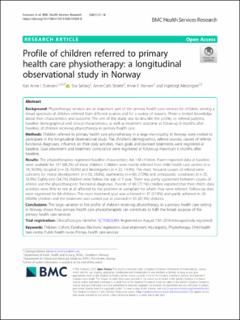| dc.contributor.author | Evensen, Kari Anne Indredavik | |
| dc.contributor.author | Sellæg, Siw | |
| dc.contributor.author | Stræte, Anne-Cath | |
| dc.contributor.author | Hansen, Anne Elisabeth | |
| dc.contributor.author | Meisingset, Ingebrigt | |
| dc.date.accessioned | 2021-03-05T13:16:36Z | |
| dc.date.available | 2021-03-05T13:16:36Z | |
| dc.date.created | 2021-01-20T13:05:07Z | |
| dc.date.issued | 2021 | |
| dc.identifier.citation | BMC Health Services Research. 2021, 21:16 1-10. | en_US |
| dc.identifier.issn | 1472-6963 | |
| dc.identifier.uri | https://hdl.handle.net/11250/2731911 | |
| dc.description.abstract | Background
Physiotherapy services are an important part of the primary health care services for children, serving a broad spectrum of children referred from different sources and for a variety of reasons. There is limited knowledge about their characteristics and outcome. The aim of this study was to describe the profile, i.e. referral patterns, baseline demographical and clinical characteristics, as well as treatment outcome at follow-up 6 months after baseline, of children receiving physiotherapy in primary health care.
Methods
Children referred to primary health care physiotherapy in a large municipality in Norway were invited to participate in this longitudinal observational study. The children’s demographics, referral sources, causes of referral, functional diagnoses, influence on their daily activities, main goals and planned treatments were registered at baseline. Goal attainment and treatment compliance were registered at follow-up maximum 6 months after baseline.
Results
The physiotherapists registered baseline characteristics for 148 children. Parent-reported data at baseline were available for 101 (68.2%) of these children. Children were mainly referred from child health care centres (n = 74; 50.0%), hospital (n = 25; 16.9%) and kindergarten (n = 22; 14.9%). The most frequent causes of referral were concerns for motor development (n = 50; 33.8%), asymmetry (n = 40; 27.0%) and orthopaedic conditions (n = 25; 16.9%). Eighty-one (54.7%) children were below the age of 1 year. There was partly agreement between causes of referral and the physiotherapists’ functional diagnoses. Parents of 69 (71.1%) children reported that their child’s daily activities were little to not at all affected by the problem or complaint for which they were referred. Follow-up data were registered for 64 children. The main treatment goal was achieved in 37 (57.8%) and partly achieved in 26 (40.6%) children and the treatment was carried out as planned in 55 (87.3%) children.
Conclusions
The large variation in the profile of children receiving physiotherapy in a primary health care setting in Norway shows how primary health care physiotherapists can contribute to fulfil the broad purpose of the primary health care services.
Trial registration
ClinicalTrials.gov Identifier: NCT03626389. Registered on August 13th 2018 (retrospectively registered). | en_US |
| dc.language.iso | eng | en_US |
| dc.publisher | BMC | en_US |
| dc.rights | Navngivelse 4.0 Internasjonal | * |
| dc.rights.uri | http://creativecommons.org/licenses/by/4.0/deed.no | * |
| dc.title | Profile of children referred to primary health care physiotherapy: a longitudinal observational study in Norway | en_US |
| dc.type | Peer reviewed | en_US |
| dc.type | Journal article | en_US |
| dc.description.version | publishedVersion | en_US |
| dc.source.pagenumber | 1-10 | en_US |
| dc.source.volume | 21:16 | en_US |
| dc.source.journal | BMC Health Services Research | en_US |
| dc.identifier.doi | 10.1186/s12913-020-05988-8 | |
| dc.identifier.cristin | 1875474 | |
| cristin.ispublished | true | |
| cristin.fulltext | original | |
| cristin.qualitycode | 2 | |

